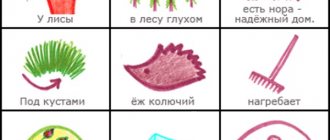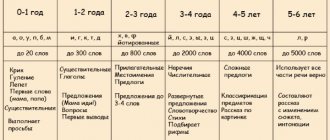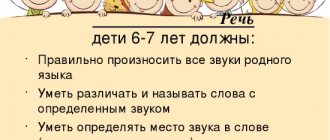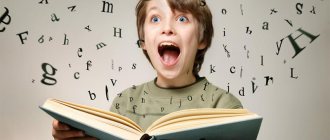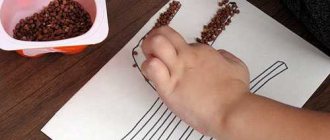- home
- Speech development
The formation and active development of the level of coherent speech for preschoolers requires not only the increased attention of both parents, but also specialized classes that can be conducted in a playful or theatrical form, which is especially attractive to children. In the process of working with children, speech therapists and teachers use many modern techniques, among which mnemonics stands out, aimed at actively developing the level of coherent speech and memory in preschool children.
What is mnemonics
Mnemonics for increasing the level of speech development is a set of techniques aimed at improving perception with memorization of various information using sound samples and visual illustrations.
Provided that classes are carried out systematically, mnemonics for speech development allow you to:
- improve the memorization of heard texts in the form of stories, fairy tales, etc.;
- transform visually acquired data into abstract (and vice versa);
- create logical chains of events;
- Expand words knowledge;
- stimulate the development of imagination and thinking;
- develop children’s ability to compose complex sentences of a descriptive type, which include many words.
Mnemonics, as one of the most effective methods of memorization, is actively used not only by speech therapists, but also by teachers in kindergartens and other preschool institutions.
There are no age restrictions for classes, but many specialized experts recognize the age of 4-5 years as the most optimal, when children already have a fairly rich and varied stock of words and phrases that they can actively use.
The main tool that is used in mnemonics for developing the level of coherent speech in preschool children are mnemonic tables - specific diagrams in which certain information data is embedded.
Mnemonic diagrams for the little ones should be painted in bright shades so that the image that a frog is green, a chicken is yellow, etc. is imprinted in their minds.
For older children, it is preferable to use single-color schemes that do not distract attention, distracting them with additional, and often unnecessary, details.
Stages of speech development
The foundations are laid during the first year, and the age of up to three years is decisive in speech therapy development. It is important for babies and toddlers to hear people speak and see expressive articulation.
The pre-speech stage continues until approximately 3-4 years, when the child communicates using crying, gestures, babbling, etc.
At 3-4 years old, funny kids begin to have long conversations with their families, although they are not always meaningful. The child quickly learns new words, but may incorrectly use prepositions, word forms, etc.
A four-year-old can and should know by heart and understand the meaning of some poems. Compose sentences longer than 4 words. Use pronouns. Tell long stories in the correct sequence. To ask questions.
Older preschoolers actively increase their vocabulary, improve the grammatically correct use of word forms, hear individual sounds (at the beginning, middle, end of a word), and can participate in dialogue on equal terms.
By school, the child has a passive vocabulary of 20,000 to 26,000 words .
Areas of use of mnemonic tables
Mnemonic tables for the formation and development of coherent speech (developmental and educational) are images of textual information that is previously divided into groups of words in sequential order. There is one illustration for each group of words. Thanks to such a schematic sketch of information, the baby easily perceives it, remembering everything without much effort.
Using mnemonic tables for speech development, the following is carried out:
- Memorizing fairy tales or rhymes. Young children take part with great interest in educational games based on fairy tales they know. At home, you can invite your child to tell a story to his favorite toy, using a series of pictures. You can also draw a mnemonic table together, depicting the heroes of events with your own invented symbols, for example, a triangle is a person, a wavy line is a cloud in the sky. Thus, not only the formation of coherent speech occurs, but also the active development of imagination and fantasy with the manifestation of the hidden creative abilities of children.
- Learning general rules, such as how to brush your teeth correctly. The diagrams depict the sequence of all manipulations that are easily perceived and remembered.
- Compiling stories describing objects, events, pets, etc. Focusing on pictures that answer basic questions: who is it, what color is it, what sounds does it make, what does it like to eat, etc., children can create a consistent description.
- Working on a retelling. After reading the text, the most difficult words are highlighted, the meaning of which must be explained to the child. After the explanations, a conversation should be held on the entire content of the text with a demonstration of drawings from the mnemonic table. A joint retelling using pictures will allow the child to quickly remember information and tell the story he heard himself.
- Solving riddles. With the help of mnemonic tables, children learn to identify an exact object, focusing on its characteristics. At the first stage, it is necessary to explain to the child everything that is depicted in each picture, and only after that offer to independently guess the encrypted object.
Speech therapy classes on the development of coherent speech using a variety of mnemonic diagrams involve memorizing and deciphering the plot illustrations given in the table. The type and thematic content of mnemonic tables can be different; execution can be printed (Doman cards) or made by hand. Cards for speech development in the first lessons should be small with light storylines; it is recommended to place 3-4 of them in one row, in this position they are easier to perceive.
Do-it-yourself didactic games for speech development
You can make games with your own hands for children in the middle and older groups of kindergarten. For creation, available materials are suitable, and the tools are available in every home and kindergarten:
- paper (thick);
- colour pencils;
- printer (color);
- glue;
- scissors;
- magazines with pictures.
Set "Runs and runs"
Didactic games for speech development for older groups
A set of pictures to activate the verb dictionary “Runs and lies” is intended to expand vocabulary and develop skills in the correct use of verbs. 27 pictures are divided into 2 types: paired ones depict people and animals performing any one action, and unpaired ones (people performing actions characteristic only of humans). The set is easy to make with your own hands using the above tools and materials.
Fairy tales are also used using toys. The child learns together with the characters of his favorite fairy tales.
Note! The goal of the game is to develop creative and associative thinking, memory and expand vocabulary. Use homemade toys.
Children are given the task of making a character from their favorite fairy tale from paper or other materials (fabric, clay). After the toys are ready, the children choose one of the characters and retell in their own words his role in the fairy tale.
Mnemotables
Mnemonic tables are special pictures where, to determine a specific word or phrase, an object associated with it is schematically depicted. They are used to develop visual and auditory memory, associative thinking and coherent speech. Benefits of use:
- Information about words is linked to visual images and sounds.
- The child’s brain simultaneously receives several signals from different sources: hearing, visual, tactile.
- The signals are combined, creating complex neural connections and a single image in the brain, facilitating the processes of memorizing, storing and reproducing information.
- It is enough for a child to remember one of the elements of an associative series for the brain to reproduce a complete image.
How to make a lapbook for speech development with your own hands in a preschool educational institution
Note! Making mnemonic tables does not require special skills or talents. It is enough to choose a word or sentence and images that clearly illustrate them. These images are combined into one step-by-step slide (glued together in the correct sequence).
Example of a mnemonic table
Note! The game “Tell a fairy tale using pictures” is a vivid example of the use of mnemonic tables. The essence: children are shown mnemonic tables with illustrations of children's fairy tales, and the kids describe in their own words the actions taking place. Fairy tale cards can be downloaded online and printed.
The best board games for children 6-7 years old
Popular:
- "Pockets with a surprise." Goal: formation and improvement of tactile sensations and perception, consolidation of the skills to recognize objects by touch and name them out loud, development of fine motor skills and attention in younger groups. The bottom line: in pockets that can be easily sewn from scraps of fabric, pictures with raised letters and numbers are hidden. The child’s task: taking a picture out of the “pocket”, by touch, accurately identify and name the letter or number depicted on it.
- Series of mnemonic tables “Seasons”. The tables depict the seasons and can be signed with lines from poetry. Preschoolers learn the names of the seasons, train their memory and expand their vocabulary.
- “Find the odd one out in the pictures (4th extra one)” - a do-it-yourself game for developing speech in the preparatory group. Goal: development of logical thinking in preschoolers. The pictures show 4 objects (animals, plants, objects), one of which is clearly not suitable for the associative series. The child’s task is not only to identify what is superfluous, but also to logically explain why.
Note! Thus, play activities have a key influence on the development of speech in preschool children. It is important to train your child from childhood.
How to create mnemonic tables
Drawing up mnemonic tables involves performing the following manipulations:
- breaking the text into parts (focusing on the most important points);
- dividing a sheet of paper into squares (the number of squares depends on the highlighted parts of the story);
- depiction of each moment in the picture (both nouns and adjectives can be described);
- words that are difficult to sketch (verbs or questions) can be depicted as a “?” (the child must comment on them).
To facilitate the perception of fairy tales or riddles by young children, the works are broken down into individual situations, which are subsequently transferred to pictures for children.
Signs of speech development disorder
If a child has any deviation, his speech in basic indicators will lag behind the norm. This can be determined by the following signs:
- confuses sounds by ear, has difficulty identifying them in a word;
- has difficulty mastering sound-letter analysis;
- communicates with others using simple sentences, omits prepositions;
- the agreement of words in a sentence is disrupted or there is difficulty in agreeing certain parts of speech;
- difficult to understand complex speech structures;
- has difficulty understanding hidden meanings in stories and abstract concepts;
- the number of words used in speech is limited;
- composes a story or retells it with the help of adults;
- it is difficult to understand and draw up logical chains;
- low need to communicate with others.
If by the age of 6-7 years the listed deviations in speech development are observed, it is necessary to conduct speech therapy classes and perform special exercises for this age category of children.
Features of use
When practicing in the form of a game with mnemonic tables, children are asked to:
- review speech therapy cards;
- remember what is described;
- talk about what you saw, focusing on the pictures.
When children use mnemonics and perform assigned tasks, they actively carry out the following processes:
- viewing diagrams and understanding what you see;
- transformation of visual data into figurative data, identification of what is seen with a concept;
- compiling a story based on drawings;
- memorizing fairy tales, stories, etc.
Older preschoolers can themselves take part in compiling mnemonic tables, focusing on the words of the teacher, who broke the story (fairy tale, riddle) into situations, explaining what needs to be drawn. The simplest and most interesting option is to depict a mnemonic table on the theme of the seasons (summer, winter, etc.) or based on fairy tales (best of all, your favorite ones).
The development of children's coherent speech in older preschool age is also possible and necessary at home (at any time convenient for parents and the baby). This can help:
- joint reading of books with fairy tales, equipped with bright illustrations, reciting the main points and highlighting key characters and events;
- regular use of fiction as an effective means for increasing the level of development of coherent speech;
- a large book with tasks and exercises aimed at the active development of a child’s coherent speech (can be purchased in the children’s educational literature department of any bookstore);
- Doman cards;
- methodological recommendations for the development of coherent speech; other methods at the discretion of parents and the advice of teachers and speech therapists.
Learning to write and read
Moms and dads strive for their child to learn to read and write as early as possible. But psychologists and neurologists do not recommend doing this. Firstly, the child must master new skills in a timely manner (and earlier does not always mean better), and secondly, children need to be taught using a special method. It is owned by kindergarten teachers and primary school teachers, but parents can make many mistakes and only harm their child.
Instead, focus on preparing to master new skills.
Learn sounds. Moms and dads often teach their children letters, but this is wrong. Words are built not on letters, but on sounds.
Train your articulation apparatus. This is the key to correct pronunciation.
Learn to write in block letters, not in capital letters. Schools use the continuous writing method. Other techniques will only do harm; the student will have to relearn, and this is much more difficult.
Get your little hand ready to write. Let him draw, cut out, hatch, paint, put together a mosaic, draw dots on checkered paper - this trains fine motor skills, muscles, and develops spatial orientation.
Let's talk separately about the sound-letter analysis of words. This is where preschoolers begin to be taught to read.
Learn to read step by step
Stage one - learning sounds.
- Start by learning a group of sounds. Use a primer or alphabet - learn in the same sequence.
- Tell us about vowels and consonants. How to pronounce them (drawn out, abruptly), how they differ.
- Tell us about syllables. Show how you can make a syllable from two sounds. Talk about the difference between letters (they are written) and sounds (they are pronounced). Show examples, for example “ma”, “sha”, “ra”, “ma”.
- It is correct to teach your child: “b”, “p”, “v”, and not the letters “be”, “pe”, “ve”. Otherwise, the daughter or son will read letter by letter: “Me - a - sha - a”, place “Ma-sha”. It will be more difficult and longer for him to learn to read by syllables, then by words. Complex words will even look like puzzles: “a - ve - te - o - be - y - es” instead of “av-to-bus” is much more difficult to perceive.
Stage two - read:
- We learn to combine sounds into syllables. Task for the baby: pronounce the first sound in the word until he reads the second: “m-m-m-m-a-a”;
- Finding syllables in a word. Assignment: ask your son or daughter to find certain combinations of letters in a word. Let him read them;
- We make up new words. Ask your child to make up a few words from familiar syllables and read them;
- Adding sounds. The baby adds one sound to familiar syllables, reads, composes new syllables, words;
- Learning to read closed syllables. First, show the difference between an open (“ka”) and a closed (“an”) syllable.
If the preschooler has completed these stages successfully, you can complicate the task - move on to more complex words, and then to sentences.
Pay attention to the fact that the child puts the emphasis correctly and understands the meaning of the words read. If he doesn’t understand, explain. Practice in the form of a game.
Mnemonic tables for children with OHP
The concept of coherent speech and its significance for the development of a child with general speech underdevelopment (GSD) has a direct relationship with the logic of thinking and the ability to comprehend images seen or sounds heard, expressing this in sequential speech in which logical chains are present. The general level of development of coherent speech inherent in preschoolers with ODD depends on the ability to think through information and construct statements on a variety of topics.
Dialogical speech is displayed in the communication of several people, often accompanied by simple monosyllabic statements, asking specific questions and composing options for answers to the interlocutor’s questions, followed by reproduction of the selected answer. In this process, a special role is played by formulating and asking questions, constructing answers and reasoned defense of one’s opinion. Coherent monologue speech in preschoolers is characterized by expansion and concentration of thoughts on the main thing, without delving into details. In the process of reproducing one’s thoughts and choosing linguistic means, internal motives play a decisive role, since it is they that stimulate monologue speech.
The features of the stages of development of coherent monologue and dialogic speech vary, but both types are closely interrelated. This nuance must be taken into account when conducting classes aimed at stimulating the development of coherent speech in children with ODD.
The introduction of mnemonics into speech development classes for preschool children should be carried out with the help of mnemonic squares, in which the simplest words are encrypted (boy, girl, sun). Only after children understand the concept of “encryption” can they move on to more difficult variants of schemes - mnemonic tracks with mnemonic tables, which can be based on a whole story.
Mnemonic track “Two funny geese”.
Using this technique during classes with children with special needs allows:
- increase attention and interest in games with logic cards;
- facilitate the perception and processing of information data that
- are stored in memory and can be played back if necessary.
Speech development disorders and their prevention
Most often in older preschoolers these disorders manifest themselves in incorrect pronunciation. There are several types of violations:
- dyslalia - incorrectly pronounces individual sounds, which is quickly eliminated with the help of a speech therapist;
- dysarthria - articulation and voice formation are impaired, the help of a neurologist is needed;
- rhinolalia - incorrect pronunciation of sounds, the voice is monotonous, slurred, the help of an otolaryngologist is needed;
- motor alalia - children understand everything, but cannot speak coherently, incorrectly agree words by gender, number, case;
- sensory alalia - children do not understand the meaning of words addressed to them, they need the help of a neurologist, psychiatrist, speech therapist-defectologist;
- aphasia - a disorder due to neuroinfection or traumatic brain injury;
- reactive mutism - the child used to speak, but then abruptly stopped due to a neurological disease;
- stuttering - lack of fluency of speech, a 6-year-old child repeats syllables and sounds, speaks intermittently.
Another group is speech delay (SD) against the background of mental disorders (MD).
Prevention of disorders by a speech therapist
To prevent problems in a 7-year-old child, it is necessary to develop him from early childhood: talk to him, show him, name objects, read fairy tales, nursery rhymes, sing songs, develop fine motor skills.
The help of a speech therapist would be helpful. It helps the little patient develop articulatory and fine motor skills; cognitive processes, skills of analyzing what is heard.
